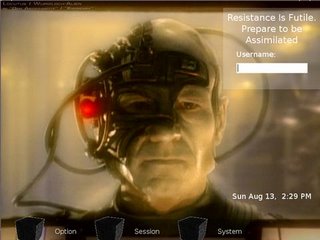Over on Penguin Pete's blog we're having a discussion about a recent Eric S. Raymond interview, where he says that, in order to achieve a significant market share, Linux needs to get into the business of using not only Unfree, but Commercial (meaning $$$) drivers. Though he doesn't say it, this would circumvent the upcoming DRM crisis, where you'll be required to ask permission, very nicely, to play home videos you made of you and the missus on your own TV. ESR's idea is that, since the iPod generation (warning: an old fart is writing this post) is perfectly willing to accept all sorts of restrictions in order to play the latest, over loud, unmusical, misogynistic and racist drivel (told ya) into their pearly white earbuds, the only way to get Linux to the next level is to go over to the Dark Side and embrace commercial drivers for our hardware, just like Apple and Microsoft. (Though getting some things to work under Windows isn't all that easy. Then, this argument goes (I think): once Linux achieves a significant (20%? 30%?) share of the market, the hardware manufacturers will realize that Open Source is Great, open the code to all their software, and everyone will live in peace and harmony forevermore, we can all watch Grey's Anatomy DVDs legally, and everyone gets to keep their guns.
Some see this as a sellout of the principles of the Free Software movement. I see it as an attempt at pragmatism. A naive attempt, of course. For what the hardware manufacturers will see is that hey, Geeks are paying money for our drivers and jack up the price.
And, of course, the whole point of ESR's argument is that Linux should achieve, if not Total World Domination, or, at the very least a Significant Market Share. But why the heck should I care? I mean, I don't give a flying freckled frak what OS you use, do I? Just so long as I can use my software of choice.
Then, every once in a while, it hits me. Linux must achieve Total World Domination. Why, you ask?
Because I'm one of those who cleans up the mess left over by a certain other OS. And I'd rather not have that job.
Every once in a while I forget this, but events soon remind me.
Like this week. Follow:
* * * * * * * * * * *
I. As I mentioned earlier, we recently drove Child1 down to a rather large campus where everyone wears Orange and Blue (eehw!). Coming back up to civilization we stopped at Brother-In-Law's house, where my POSSLQ-in-law told me the "humorous" story of how they had clicked on some link on the web and all of a sudden the computer had filled up with all sorts of p0rn popups. Aaargh! I should have run to that computer, wiped it clean, reinstalled Windows, installed Firefox, Thunderbird, the Google Pack, a good virus checker and firewall, and informed B-and-POSSLQ-in-law that they weren't coming near this computer until they learned some common sense.
In the interest of family harmony, as well as wanting to get home before Christmas, I refrained. I know I will regret this, as they have several of my email addresses. So virii will soon be going out over email with my name attached, and will be cheerfully opened, since "well, HE wouldn't be sending us an email with a virus, would he?" (If B&POSSLQ-IL ever read this, I'm dead. I know it, it was worth it.)
II. On weekends, I tend to get up earlier than everyone else. Fair enough. During the school year they get up at 5:30. Getting up early means I have a chance to to some caretaking on the Windows machine. (See, I don't discriminate: besides, if you don't have a machine that works with Flash 8, how can you see all the Sci-Fi channel promos?) The routine is: 1) Run Virus Scan; 2) Run Spyware Scan; 3) Check for and Install Updates; 4) Reboot and watch Flash 8 animations until someone else gets up.
Now since we have large disks with lots of files, 1) and 2) take a lot of time. So last night I had a brilliant idea: after everyone went to bed, I got up and started the virus scan.
Bad idea. Why? Because, for reasons that escape me, but I'm sure seemed like a good idea at the time, Windows is set to auto-update at 3 am, which turned out to be right in the middle of the virus scan. I forgot this because ordinarily the machine isn't on at 3 am, forcing me to update by hand.
So Windows was updating itself at the same time that the virus checker was scanning everything.
Nothing bad happened until I rebooted. Then I found that the wireless connection had gone south. I noticed this because I kept getting error messages saying that some Symantec software had terminated in a strange way, beyond the comprehension of my machine.
Plus, I couldn't access the Internet. And when I clicked on the little monitor screen in the System Tray it told me that it was "Acquiring Network Address."
Now the wireless has been a bit flaky for a month or two, so I wasn't all that worried. Eventually it would connect.
Except that it never did. Even though the network looked fine on the Apple (wireless) and the Linux box (hardwired). After repeated reboots.
I began to curse and pound furniture. I probably awakened Spouse and Child2. That's OK, school starts on Tuesday and they need to start getting up earlier. The cursing didn't have any effect on the computer.
I was positive/sure/damn sure that this was a wireless problem. So I moved the box, keyboard, mouse and monitor down to the office, where I could stretch an Ethernet cable from the router to the box. Then everything would work, right?
Wrong. Same error. I made sure the wireless card was turned off and the Ethernet port on. I rebooted again and again. I searched the Internet, and found that this was a common problem, but none of the fixes I tried worked — I wasn't at the point where I would want to reinstall the network drivers.
I even broke down and called a neighbor who is more experienced with Windows than I. (No, I don't ask for directions, either.) He was stumped as well.
Finally, just before telling Spouse and Child2 that they were going to use Linux and like it, I remembered that there was a software update to be installed, and figured out that it must have installed last night. Maybe this was the cause of the problem?
Windows has a marvelous utility called "System Restore," which takes the OS back to a previous point, before you added some software which broke everything. (There may be some Linux systems that have such a thing, but I haven't needed it with Ubuntu so I haven't looked. With Fedora I certainly could have used it once or twice.) A breakpoint was set for 12:30 am this morning. I went back to that, rebooted, and voila, I had a wireless connection. Then, in a masochistic mode, I reinstalled the update, and, whatdoyaknow, the thing worked. Apparently the combination of installing the update and running the virus scan had messed with the registry or something. Anyway, it's fixed.
Oh, yeah, the update? It was the latest version of Windows Genuine Advantage, undoubtedly the most useless program in the history of civilization. (I bought a Dell with XP installed. If Dell is pirating XP, then Microsoft is dead. Microsoft is alive, so QED.)
This took about eight hours of my life, less meals, shower, and coffee breaks.
III. Just got off the phone with my brother. He's gotten himself a donated machine running Windows 98. The screen resolution is stuck on 640×480. I scream.
* * * * * * * * * * *
And so it goes. True, this was a rather unusual week, but these things happen every so often — remind me to tell you the story of how I had to install Linux on a computer before I could re-install Windows.
And I'm just a dabbler in the computer repair business. Imagine what the pros go through. (I don't have to imagine, I employ a pro at work.)
Linux (or BSD, or Solaris, or OS2, or even BeOS) World Domination can't come soon enough. Save me (and real pros) from having to fix Windows!
Windows delenda est

















